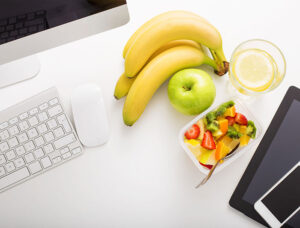Five Ways to “Green Up” Your Lunch Routine
- By Elisabeth Flynn
- Reading Time: 4 mins.
The numbers are staggering. Americans go through more than 100 million pieces of plastic utensils and throw away 500 million plastic straws a day, according to the nonprofit Plastic Pollution Coalition.
 If you’re in the habit of dining out for lunch—grabbing a sandwich from the corner deli, a meal at your favorite fast food joint, or ordering takeout for the team—then you’re most likely contributing to this mounting ecological crisis. How many sets of plastic cutlery (which are frequently sheathed in more plastic) are currently in your desk drawer or floating around your office kitchen?
If you’re in the habit of dining out for lunch—grabbing a sandwich from the corner deli, a meal at your favorite fast food joint, or ordering takeout for the team—then you’re most likely contributing to this mounting ecological crisis. How many sets of plastic cutlery (which are frequently sheathed in more plastic) are currently in your desk drawer or floating around your office kitchen?
Even though plenty of food packaging is technically recyclable, the U.S. has one of the lowest overall recycling rates of any developed nation. Far too much plastic quickly passes through our hands, then ends up in a landfill or the ocean, to devastating effects.
When it comes to work lunches, we’re often pressed for time, making choices out of convenience. The good news is there’s a lot you can do to cut down on your personal plastic use—and you can encourage office mates to do the same.
Easy Ways to Reduce Your Plastic Use
In honor of Earth Day (April 22), we’re offering these five simple ways to reduce your personal plastic use and “green up” your lunch routine at the office:
1. Bring food from home. Whether you pack it in Pyrex, Tupperware, Mason jars, or leftover take-out containers, bringing your lunch from home is one clear way to cut back on disposable items. It’ll also help you save money and can aid in weight loss, too. (Looking for a great office lunch meal-prep guide? We have one here.)
2. Choose real utensils. It’s as easy as bringing a knife, fork, and spoon from home to work. You can rinse them in the kitchen after each use and stash them away. If you’d rather not break up your home set, consider something like these spiffy sets of bamboo cutlery from to-goware.com. (I got one as a gift last year and am totally hooked —they’re super lightweight, dishwasher-safe, and convenient to carry.)
 3. BYO water bottle and coffee mug. Time for more scary statistics: Every minute, close to 1 million plastic water bottles are sold around the globe. More than 90% of them don’t get recycled. If you’re in the habit of buying bottled water, stop. Choosing a reusable bottle saves about 217 plastic water bottles each year from the landfill. Water is key to maintaining optimal health, and from stainless steel to vacuum insulated, filtering to fruit-infusing, there are an array of options. If aesthetics are important, or you just like to geek out on product reviews, New York Magazine’s Strategist shopping guide recently published a great rundown on the countless options out there. Again, you’ll save money and help cut down on plastic waste.
3. BYO water bottle and coffee mug. Time for more scary statistics: Every minute, close to 1 million plastic water bottles are sold around the globe. More than 90% of them don’t get recycled. If you’re in the habit of buying bottled water, stop. Choosing a reusable bottle saves about 217 plastic water bottles each year from the landfill. Water is key to maintaining optimal health, and from stainless steel to vacuum insulated, filtering to fruit-infusing, there are an array of options. If aesthetics are important, or you just like to geek out on product reviews, New York Magazine’s Strategist shopping guide recently published a great rundown on the countless options out there. Again, you’ll save money and help cut down on plastic waste.
When it comes to coffee, if you’re still relying on disposable cups every day, then it’s time to step up your game. Most disposable paper coffee cups are lined with plastic polyethylene, which is tightly bonded to the paper coffee cups and makes them difficult to recycle. Grab a mug from home and stash it at your desk or workstation. If you enjoy a to-go cup of joe, get yourself a decent travel cup—you might even receive a discount on your coffee purchase, or at least an appreciative smile, from your favorite barista. And don’t feel limited to hot drinks; reusable cups work just as well for cold beverages.
And if you’re in charge of a catered meeting or lunch, you can reduce the plastic involved by letting everyone know in advance that it’s a BYO bottle and utensil affair. Making it a group affair will help inspire individuals to go greener on a daily basis.
4. Skip the straw (or get a reusable one). With the exception of those who have a medical reason, most of us can easily forgo the use of straws. If you’re someone who does use straws—or maybe your young children do—consider buying reusable or paper ones. If you’re getting lunch delivered or picking it up, be sure to ask that they leave plastic straws out of your order.
5. Banish plastic bags. 500 billion single-use plastic bags are used every year, but only 1–3 percent of them are recycled. The U.S. has lagged behind other countries in legislation––but California’s 2016 ban has shown a positive effect, with minimal pushback from consumers. (Hawaii has the only other statewide ban on single-use plastic bags at the moment, but New York will follow suit in 2020, and a growing number of cities and towns across the U.S.have implemented bans of their own.)
It’s not hard to adopt this habit. Reusable shopping bags and totes are everywhere—you probably have a closet full of giveaways from conferences, special events, or public radio fund drives; you can also pick one up for about a dollar at your local grocery store. Keep one at your workspace, where you can use it for any impromptu purchases or your carry-out lunch. I’ve taken to hanging one beside the front door at home, plus a few in the car, so I’ll remember when I’m heading out to the store or otherwise on the go.
Make Conscious Choices
It’s easy to feel overwhelmed by the pervasiveness of plastic in our lives. We’ve grown accustomed to having it, but we can start to cut back on its use by making some conscious choices. Most of these steps involve minor modifications to our behavior. Just as you might put your gym clothes or running shoes out the night before, you can also pack your lunch and rinse your coffee tumbler and bring them to work. Choose the new plastic-free habits that work for you. Your planet will thank you.
Need more office tips? Look no further!
Elisabeth Flynn is a Philadelphia-based writer and editor, and has spent the last 15 years working in the nonprofit/social innovation sector, including stints at the Philadelphia Museum of Art and Mazzoni Center, an LGBTQ-focused health and wellness provider.


